Gastrostomy tubes (G tubes) are feeding devices that provide liquid nutrition, medications, and other fluids directly into the stomach. G tubes are placed through a surgical opening in your child's abdomen (tummy) called a stoma. The tunnel from the outside into the stomach is called the tract.
Balloon G tubes have a balloon on the end that sits inside the stomach to keep the tube in place. These tubes may be non low-profile or low-profile.
The information in this article does not apply to GJ tubes, combination G/GJ tubes or non-balloon G tubes.
| The SickKids G-Tube Feeding Program has developed a one page guide to help you quickly troubleshoot any issues with your child's feeding tube: G-Tube Feeding Program Family One Pager |
Types of balloon G tubes
Non low-profile balloon G tubes
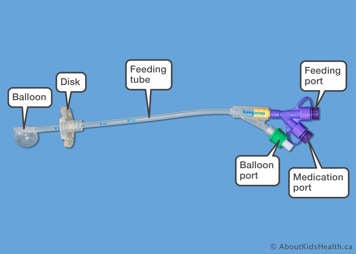
There are several brands of non low-profile balloon tubes, including:
- Avanos Mic-G
- Kangaroo
- Cook Entuit
Low-profile balloon G tubes
A low-profile balloon G tube is a type of feeding tube that sits close to the skin and is easy to conceal. These tubes are sometimes referred to as a “button” because of how they sit on the skin. It is very important to know the specific brand of tube your child has. Low-profile balloon G tubes need a special extension set to connect to the tube to feed your child.
There are several different brands of low-profile G tubes, including:
- Mic-Key
- AMT MiniONE
- Nutriport
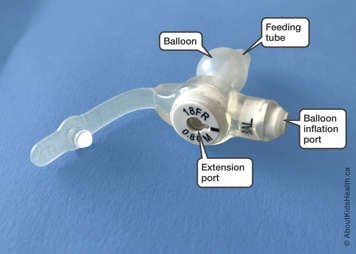
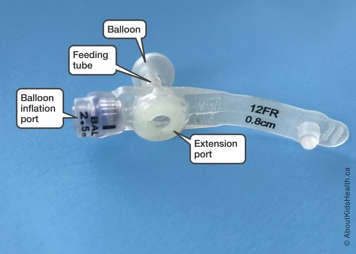
Caring for your child’s balloon G tube
Keep the tube and stoma as dry and clean as possible, washing with soap and water daily. Your child’s stoma will not need a dressing.
Flush the tube with at least 5 to 10 mL of water before and after each feed and medication dose, and every four hours during continuous feeds. This helps prevent the tube from becoming blocked.
The balloon
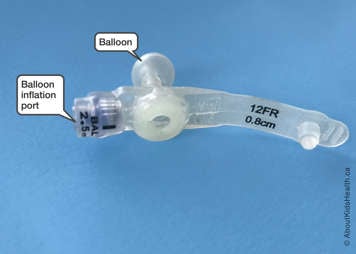
The balloon at the end of your child’s tube is what keeps the tube in place and prevents it from being accidentally pulled out. The balloon is inflated with sterile or distilled water. You may also use tap water that has been boiled and cooled down. The water is inserted through the hard plastic port, which may be marked "BAL". Do not fill the balloon with saline or air. Do not give feeds into the balloon port.
The doctor who inserts the tube may fill the balloon with less than the recommended balloon volume. If this is the case, you will need guidance from your health-care team before you increase the balloon volume.
If you are unsure how much water your child’s balloon tube can safely hold or you are not sure how much water the balloon was originally filled with, ask your G tube specialist (at SickKids this is the G Tube Resource Nurse) or refer to the chart below.
| Non-low profile |
Low-profile | |||
|---|---|---|---|---|
| Mic-G | Kangaroo | Mic-Key | AMT miniONE | |
| 12FR | 3 to 5 mL (max 7 mL) | 5 mL | 3 to 5 mL | 2 to 3 mL |
| 14FR | 3 to 5 mL (max 7 mL) | 5 mL | 5 to 10 mL | 3 to 5 mL |
Please see the article “Checking the balloon on a feeding tube” to see how to check the volume of water and adjust the fit of the balloon tube.
Feeding extension set for a low-profile balloon G tube
The feeding port for a low-profile balloon G tube is where your child’s feeds will enter the tube and then go into their stomach. The feeding port has a one-way valve to prevent stomach contents, feeds, water, and medications from flowing back out of the tube. To open this one-way valve, and give feeds and medications, you must use a feeding extension set. Each brand of a low-profile balloon G tube has their own extension set. You will receive one in the box with a newly purchased low-profile balloon G tube. Replacement extension sets are purchased separately when needed.
For more information on how to connect and remove the extension set, please see the article “How to use the feeding extension set for a low-profile balloon G tube”.
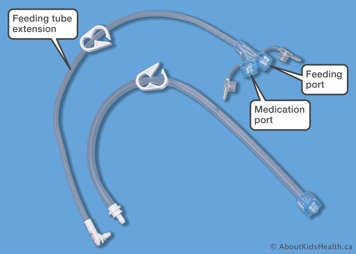
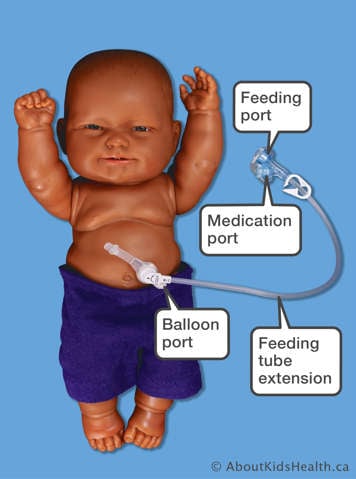
Changing the balloon G tube and checking that the newly changed tube is in the right spot
Primary balloon G tubes (i.e., surgical tubes) should not be changed in the first eight weeks from insertion.
To review how to change a balloon G tube after eight weeks and check whether the new tube is in the right spot, please see the article “How to change the balloon G tube and check tube placement”.
How often should you change the balloon G tube?
Most G tube manufacturers do not give a set time for how long you can use the tube. They suggest that it can stay in as long as it is functioning without leaks or defects. However, the tube should be changed at least every six to eight months to prevent leaks in the balloon, which could cause the tube to accidentally fall out.
It may be time to change the tube when:
- The balloon is broken
- The one-way feeding port is broken
- The balloon port is broken
- The tube is blocked
- The tube has been dislodged
When changing the tube, it is important to remember the risks involved.
Infection: When you replace the tube, the stoma and the tract can become irritated and bacteria can be introduced. This increases the risk of infection. Wash the stoma with soap and water before inserting the new tube to reduce the risk of infection. Always wash your hands before handling the tube and continue to clean the site with soap and water daily. Keep the site open to air.
Increased granulation tissue: Removing an old tube and inserting a new one can irritate the skin and cause granulation tissue. This is a common occurrence. Your G tube specialist can help you deal with granulation tissue.
Perforation: There is a possibility that, when inserting a new tube, the tube is not inserted along the existing tract. It could create a new tract and space inside the body. This is extremely rare. If your child has instant intolerance (vomiting) or severe pain after their first feeding with a new tube, stop using the tube and go to the emergency department for assistance. A G tube check may need to be scheduled in the interventional radiology department. Perforation can lead to a condition called peritonitis.
What to do if your child’s balloon G tube is pulled out, becomes blocked or migrates into the stomach
If the tube is accidentally pulled out
It is possible that the G tube may accidentally fall out or be pulled out. This may happen if the balloon is broken or does not have enough water in it.
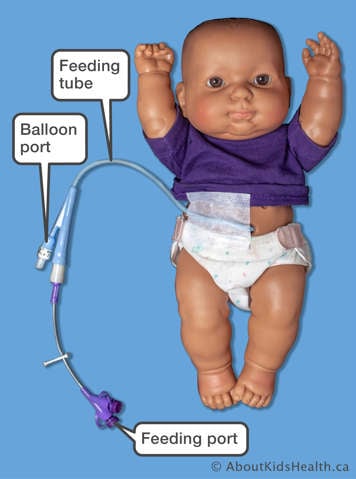
If you cannot replace the G tube, insert a temporary Foley catheter. To learn how to insert the Foley catheter, please see the article "What to do if your child’s feeding tube is pulled out". Y
If the tube becomes blocked
To learn what to do if your child’s G tube becomes blocked, please see the article "What to do if your child’s feeding tube is blocked".
G tube migration
Balloon G tubes such as Foley catheters are at high risk of migrating from the stomach into the small bowel. The tube must be secured to the abdomen with tape to prevent tube migration. To learn what to do if your child’s G tube moves, please see the article “What to do if your child’s feeding tube moves”.
Resources
For more information about the Mic-Key, visit www.tubefed.com/.
For more information about the AMT miniONE, visit www.appliedmedical.net/enteral/minione/balloon/.